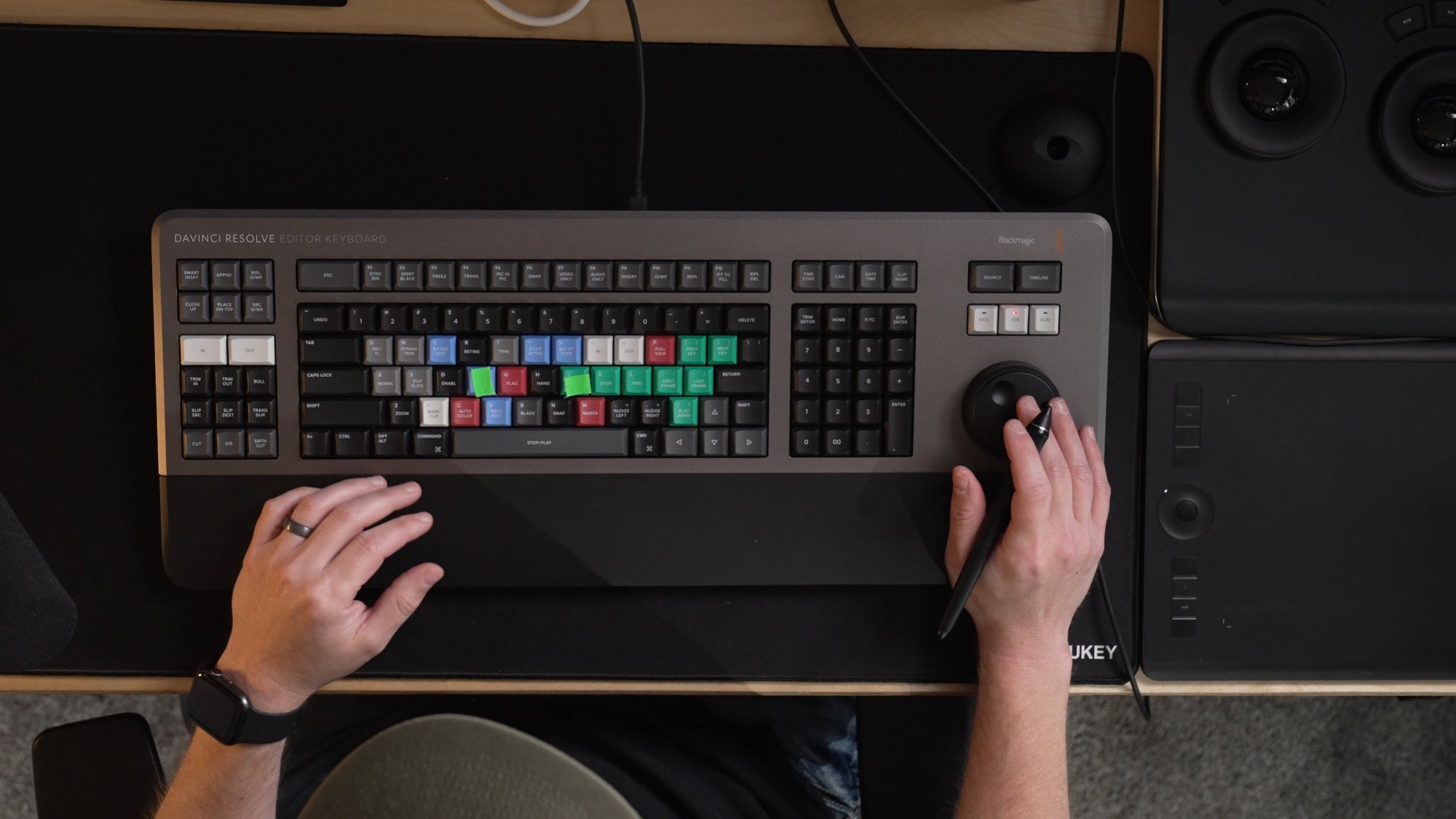DaVinci Resolve Editor Keyboard
Blackmagic Design has two specialty video editing keyboards for DaVinci Resolve. The speed editor is the little guy I purchased when it was released. And then there is this work of art—the full-size DaVinci Editor Keyboard. And man, is this thing FUN to use! Both the small speed editor and the big DaVinci keyboard come bundled with a Studio version of DaVinci Resolve and have that super cool retro jog wheel that makes it feel like you hold the timeline with your hand. It’s a tangible experience like painting in Fusion with a Wacom pen. The big DaVinci editor keyboard even has a handy insert black button to insert a beat of separation into your main story dialogue.
Let's examine what the big, fancy editor keyboard can do …to help you decide whether it's right for you.
Physical (objective observations)
It’s big, heavy, metal, measure length - clearly inspired by the sony bve-9100
Tilt up feet (laying flat is more ergonomic)
Jog Wheel, Search Dial - not the same as the speed editor, shuttle mode has gearing that kicks in with a clutch. The speed editor search dial always spins freely.
The wrist pad feels nice, doesn’t remove
Specialty buttons only on big keyboard
Video and Audio only (video only great for b-roll place on top)
Insert Black, slug
Clip Duration - select clip/ number/ then duration enter
Number Pad layout with double 00
But I lose the multiply and divide buttons on my number pad!
Bin sorting
USB Wired connection has USB hub with bigger USB A ports - I could not get my stream deck to work plugged in.
Nubs on F and J are not pronounced
No Bluetooth (no battery to charge)
No backlit lights under keys
The current price is around $600 US, but includes Resolve, which is worth half of that. So call it a $300 keyboard. The check the current price - here is my affiliate link - https://geni.us/editorkeyboard
While it looks like a speed editor with a regular keyboard in the middle, there are important details that make a subjective difference, which I want to discuss next.
Functional (subjective feelings)
Most functional on the cut page
source tape (show tape, clips run one end to end, like on a tape, or on a stringout timeline w/o making one)
smart insert, smart (nearest) edit indicator - don’t need to position the playhead precisely
sync bin
The cut page in default ripple mode is like FCP magnetic with the benefit that you never need to zoom in/out. The nearest trims work on the edit page but not smart inserts.
Jog wheel is fun (and better than speed editor)
JKL is just as functional, but feels more binary and to trim requires more button presses to select edit points to trim
Trim in, Trim Out, Roll, Slip Demo
Jog is the default go to (frame by frame), Shuttle goes faster like a jkl, scroll is the fastest. Tip - use shuttle then hit jog to stop and refine the playhead position.
No Slide function to move b-roll like on speed editor
Mechanical Keys are not the best I’ve used, especially for typing out an email (but yes, this can and should be your only keyboard at your desk). Make sound, which I like.
Layout with In/Out and edit left side and jog wheel spread wide is perfect. Space bar in the middle to play forces are to move to avoid carpul tunnel.
Every common edit function has a single defined button press
1 - this means the special buttons can’t be further customized
2 - do you really need to?
No Top and Tail, Trim Start Trim End buttons - use Mr. Alex Tech 123 custom set? Adds a missing cut-only button.
Unlike the Mini Color Panel, I can’t use it to remotely control another resolve system at another location (sometimes I edit over Jump Desktop into another post house)
There were a couple of questionable choices—smooth cut? PiP buttons? No end button (you need to use fn/home). There was a small right shift key that I would miss my first week, no option/alt on the right side for play-in-out, and combined arrow keys took getting used to. Like learning a new instrument.
Biggest Takeaways
Blackmagic gear on blackmagic software gives you a man to machine interaction and feel that does not exist on any other input device except maybe a good stylus with painting software. The smaller speed editor is an incredible value, but is an extra device on the desk, where the bigger editor keyboard can be your one and done. There are commands you’ll need to reach for on a regular keyboard if you go with the speed editor. The one I found I reached for the most was Shift Q to zoom to a clip level from source tape, or X for x marks the spot to mark an in and out point on the timeline. The big keyboard keeps my hands from reaching to another device.
When the speed editor first came out, it was $300, and the full-size keyboard was $1,000. Now, there’s only a couple hundred dollars difference in price instead of $700. Blackmagic always seems to do everything possible to make the best tools available at the lowest prices so everyone can create high-quality work. If you don’t use Davinci Resolve for editing, this keyboard's special buttons won’t be very functional and don’t make sense to buy. Or, if editing isn’t a priority for you with Resolve, the editors keys is another great option on the market that I’ve recently reviewed.
But… If you want to edit with the full-feature (Non-Subscription based) Studio version of Resolve and use a tool that makes ideas flow to screen a fast and fun experience, I think buying a speed editor or full DaVinci keyboard is a no-brainer. They're pretty similar, but hopefully, this video pointed out some of the differences.




